Before I take you on a journey of hot pot history, and teach you how to enjoy this hands-on way to eat, I’ll first tell you the story of our very first Chinese hot pot experience.
It was a team effort.
We were in Urumqi in China’s westernmost province of Xinjiang having just crossed over the border from Kyrgyzstan. Looking for a local place to eat we wandered around a few back streets where English was nowhere to be heard. We eventually spotted a little hole-in-the-wall restaurant whose windows were filled with steam and whose seats were filled with locals actively digging in, enjoying their eating experience.
We’d found the local hot pot joint.
From the moment we walked in the door, our waitress could sense that we were out of our element. We had no idea what we were doing in regards to hot pot — the protocol, the choices, the process. Fortunately, she took control, aided by her few words of broken English (against our even fewer words of Mandarin Chinese).
She brought out a split broth pot, a pan for searing, a gas stove, and two small plates. Then, she took us by the hands — quite literally — to the fresh display case of sliced meat, chopped vegetables, and dumplings. She strongly “suggested” what sorts of meats and vegetables we ought to select to cook in our bubbling broth.
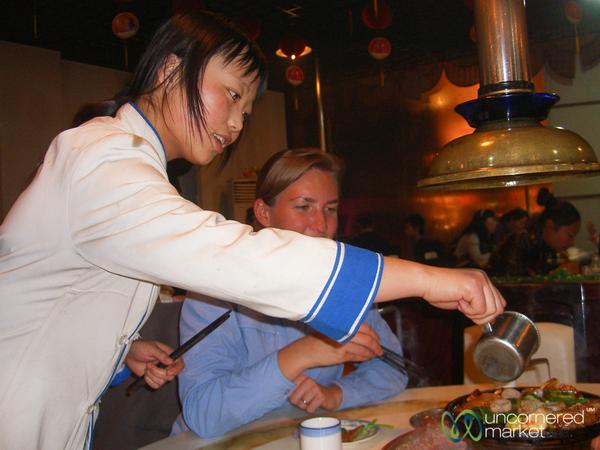
Guided through the proper hot pot experience in Urumqi, Xinjiang.
To ensure we had the perfect hot pot experience, our waitress — nay, our shepherd — regularly monitored our table, from afar and up close. Each time she sensed our struggle she paid us a visit to make things right. Any hint of violation of hot pot rules — for example, frying the tofu on the tableside pan instead of simmering it in the broth, she was there with a gentle nudge away from the transgression. Or, she would bring to us new ingredients from the bar that she felt were essential either for cooking or create new dipping sauces.
As most everyone knows, Chinese society and culture values harmony. So participation didn’t end with the interaction between our hot pot shepherd and us. For as she brought us along to a point of hot pot graduation — from neophytes to mere novices — we received nods of approval, even hearty double thumbs-up, from the other diners across the length of the restaurant. Inspired by our waitress, some would motion their recommendations as to other ingredients we ought to try. Others still, undeterred, interrupted their own tables to deliver from the fresh bar the critical components we’d missed.
You might even say that for our first hot pot experience, it took a village. Because in the city of Urumqi that night, it almost did.
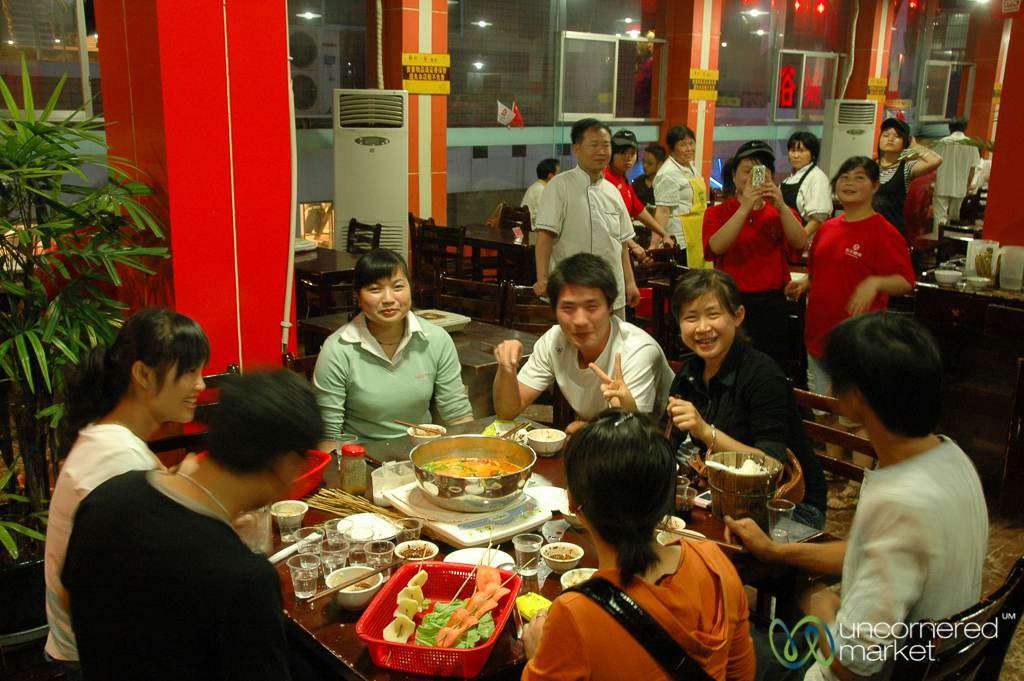
Another “it takes a village” hot pot experience in Kaili, Guizhou.
Chinese hot pot. The concept of it is simple — simmering meat, vegetables, and noodles in spicy (or plain) broth fondue in the centre of the table. However, whether you go with a group, or even by yourself, hot pot in China is so much more than just a culinary experience. It’s a cultural one — and a social one, too.
So what are the origins of Chinese hot pot and what’s the best to enjoy it?
Chinese hot pot: a brief history
The concept of Chinese Hot pot (huǒ guō) is believed to date back more than 1,000 years to the time of the Jin Dynasty. Hot pot's roots can be found in the dining practices of Mongolian horsemen who rode across the steppe and into northern China. Legend has it that the Mongols used their helmets as vessels to simmer broth over open fires, and cooked chunks of meat in that broth.
And their shields? They were used as a sort of frying pan to sear meat, of course. Mongol horseman knew how to pack light.
China resisted the Mongols. Heck, they even built the Great Wall to keep them out, which despite its splendor did not succeed. However, the Chinese took a little bit of the good with the bad and incorporated this style of eating, modifying it over the years for themselves. In the centuries that witnessed the growth of the Song Dynasty, hot pot moved — and morphed — further south into China, with each successive region adapting it to their local ingredients and tastes.
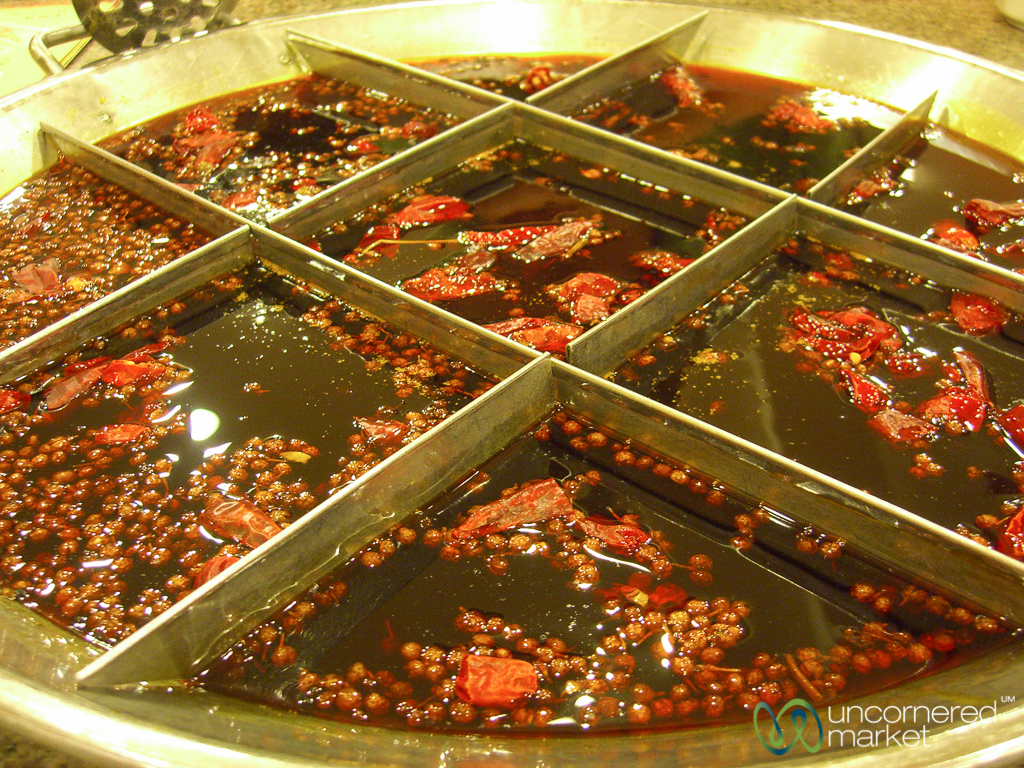
Sichuan hot pot in Chengdu with all its glorious peppers and spices.
Perhaps the most famous hot pot variation is the Chongqing or Sichuan variety. This style features a dark-red broth chock full (and often bristling) with the bits of twenty spices, chili peppers, and the uniquely mouth-numbing Sichuan pepper (huā jiāo). In Beijing, and elsewhere in the north, hot pot broth tends to be on the mild side, and compared to its racy southern cousins, a little bland. In Manchuria, a sort of local fermented sauerkraut is used to add some tang, making the broth a bit sour.
Over the course of time, through the machinery of China’s diverse culture and culinary methods, hot pot spread throughout the country and transformed from a treat enjoyed at home in winter to almost staple status, eaten all year round. You can find it now in establishments that range from street-side hot pot stands to formal indoor affairs. And while regional differences apply and prevail, today you can usually find any style of hot pot you like almost anywhere in China, particularly in larger cities.
Chinese hot pot: a how-to
By now, you’ve probably figured out that Chinese hot pot at its most basic is a straightforward concept. When you enter into a hot pot restaurant, your steps to hot pot bliss will roughly track the following process:
Choose your broth: Your choices often include plain broth, spicy (Sichuan style), or sour. If you are unsure, a reliable option is to choose a yin-yang split pot where you can enjoy two different styles at once. This will also yield some relief should you suffer the fits and throes that are likely to accompany an especially spicy broth.
Choose your ingredients: Main components run the gamut from meat and seafood, sliced vegetables and greens, fast-cooking noodles, and tofu –– all pre-cut and arranged on skewers or small plates to expedite a quick getaway to your table. Some hot pot restaurants will have a menu, while many others will operate an open buffet-style whereby you choose your own ingredients, at your own pace.
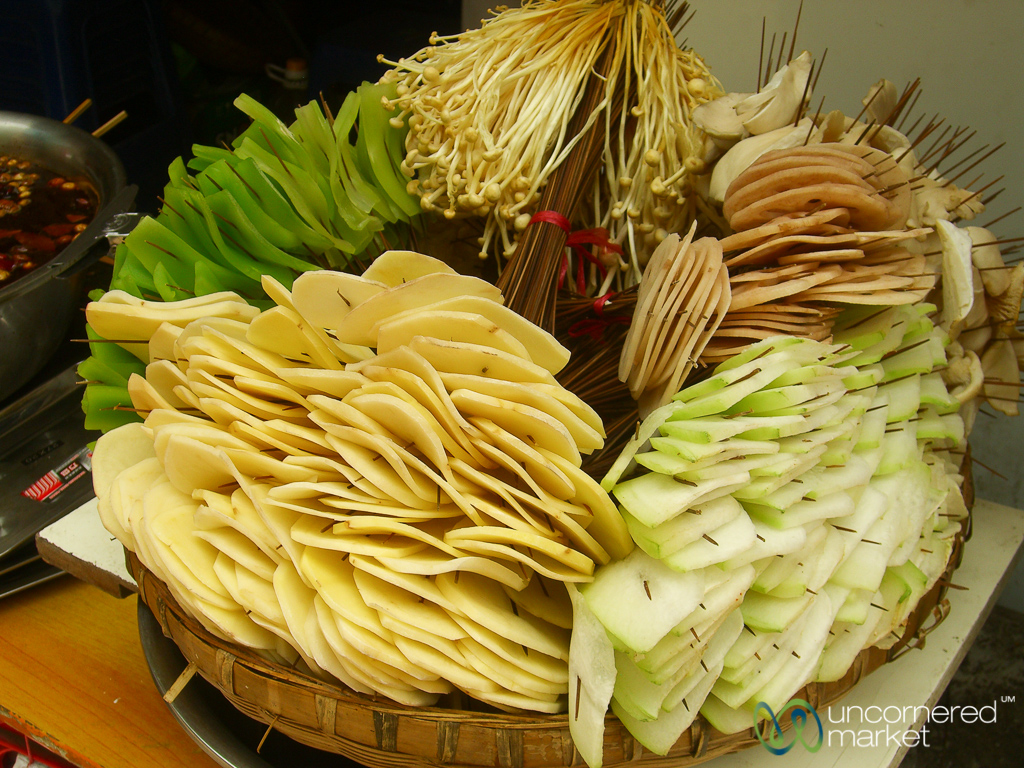
Hot pot ingredients on skewers at a street-side stall.
The latter is a bit easier if you don’t speak a lick of Mandarin (as we didn’t). You can simply take what you like, or, alternatively, point to whatever you like. Staff will likely help you, and the bill will be easily totalled based on the plates you’ve chosen.
Do-it-yourself cooking: Place the skewers and cut food items into the boiling broth. If your pot is sectioned, you can cook meat and vegetables separately, but it’s perfectly OK to cook them together. The idea is to put the ingredients that will take the longest to cook (e.g., meat and tough vegetables) in first, and then throw in the lighter ones (e.g., noodles, bean sprouts) later.
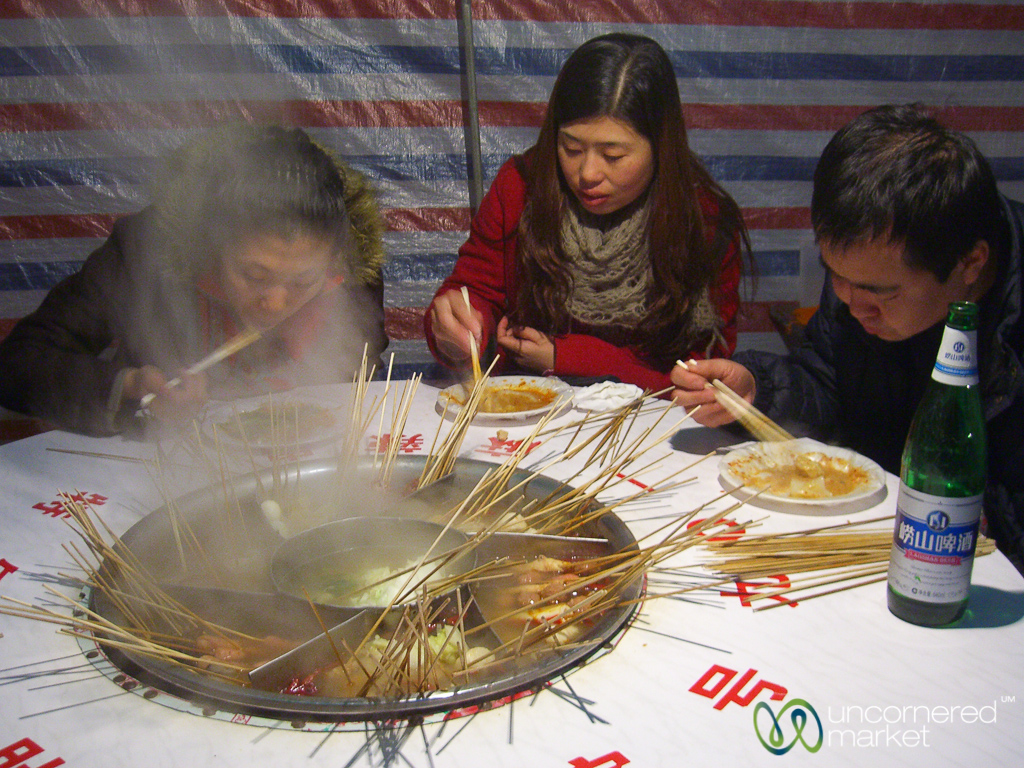
Street-side community hot pot in Qingdao, where everything cooks together.
Roughly, you’d like to end up where everything finishes cooking around the same time, so you can eat it all together. This timing bit is harder than it sounds. The good news is that it really doesn’t matter, particularly if you’re in a group. Food usually vanishes from the pot more quickly than it can be replenished.
Extract everything from the broth: When your food is cooked to your taste (be sure the meat is fully cooked) remove it and put it on your plate. If everything is on skewers, this is easy. If not, then it can be quite a game to extract all the bits and bobs from the boiling broth with your chopsticks. It’s a fun game, though, and it is made even more enjoyable when lots of people around the table are all digging into the pot at the same time. Though it can even devolve into a competition where everyone steals choice bits from each other.
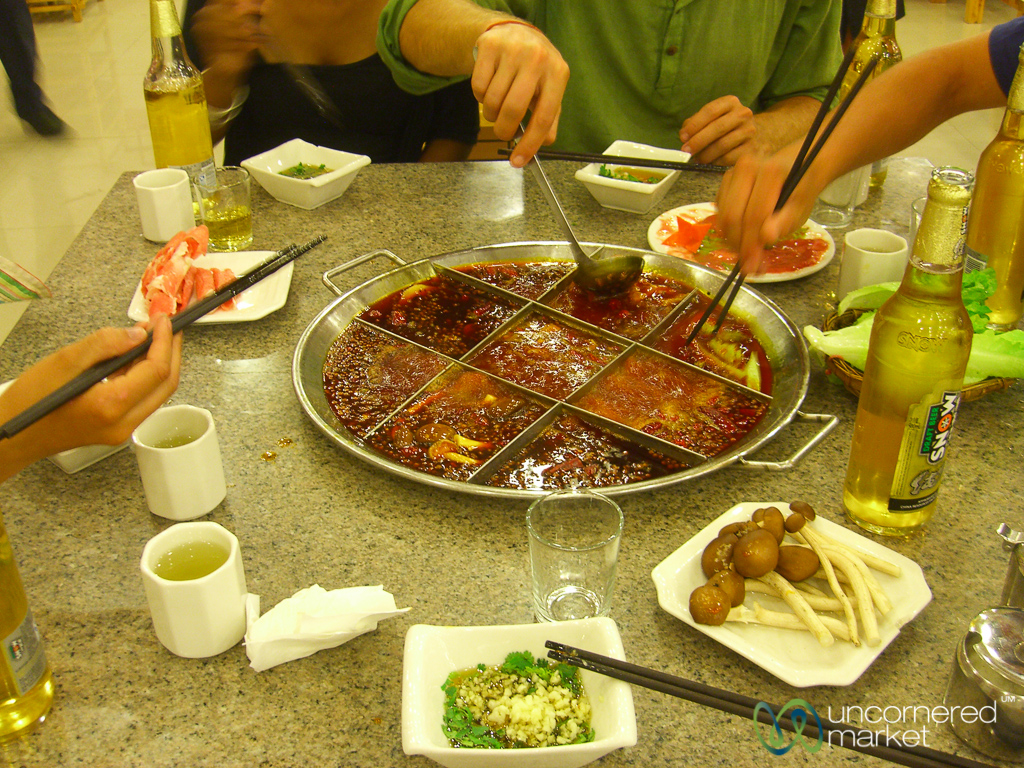
The fun of trying to extract our food from a fiery Sichuan hot pot.
Create the perfect dipping sauce: Dipping sauces perform at least two functions; they complement the flavour, and they serve as cooling agents. They can make all the difference to your hot pot experience. You’ll often be able to assemble your own sauce through some combination of the following: sesame oil, peanut oil, chili oil, soy sauce, garlic, crushed chili peppers, vinegar, pepper sauce, green onions, cilantro, and ginger.
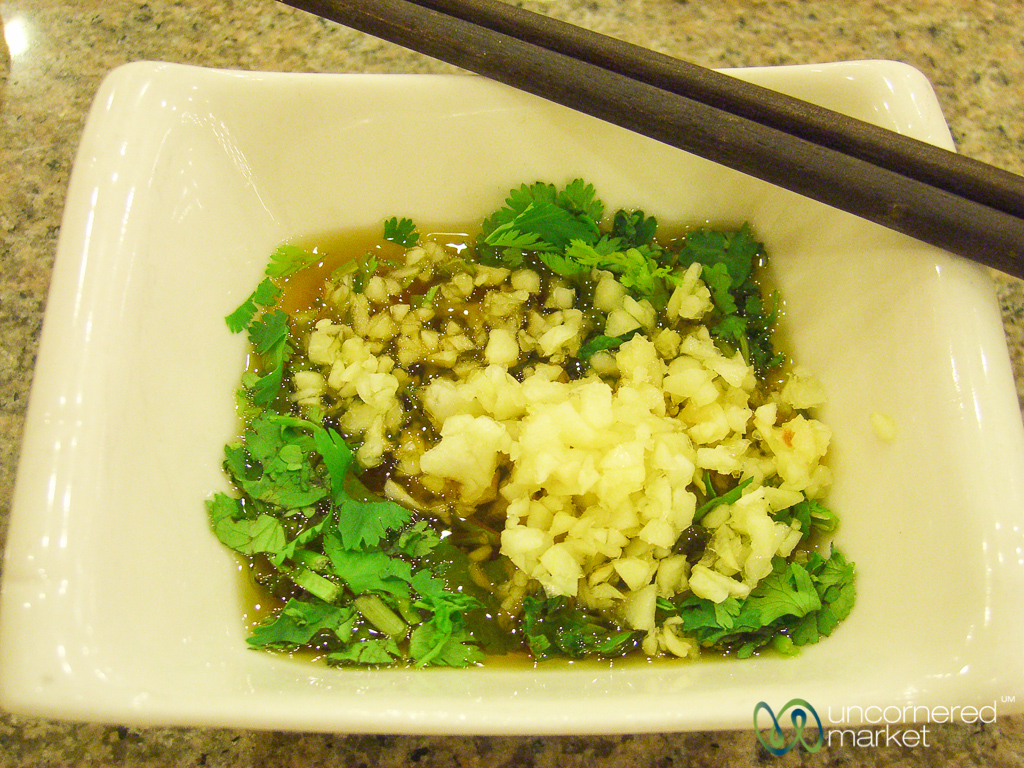
The importance of a good dipping sauce cannot be emphasized enough.
During our hot pot experience in Guizhou, a female janitor at the restaurant came over to our table and mixed us a dipping sauce that included some of the hot pot broth itself. Who knew that hot pot residue could be so tasty? This took hot pot dipping sauce to an entirely new level.
Eat and enjoy: Take the cooked food with your chopsticks, drag it through the dipping sauce(s), and chow down.
A note on physical reactions to Sichuan hot pot
If you are eating Sichuan and find your face going flush to the point of hives, don’t be alarmed. Based on our experience and observations, this is entirely normal. One trick to keep that “hurts so good” spice feeling without you melting: make a dipping sauce from peanut or sesame oil and coat the food with this just before eating it. This seems to be the ancient Chinese secret for keeping their cool amidst the spice of hot pot. We’ve also heard that drinking peanut milk (huasheng nai) can soothe the stomach and can help put out a fire in the belly.
Hot pot: so much more than just the food
Hot pot is not only a culinary experience, it’s an exercise in social connectivity. The more the merrier, and it’s a way to get to know people in a more intimate way as you share a meal. As Shao Z. notes: “you don't ‘hot pot’ with people you don't like.”
Getting There
G Adventures runs a number of departures in China encompassing a wide range of departure dates and activities to cater to different tastes. We’re thrilled at the prospect of showing you this big blue planet of ours — check out our small group trips here.
![Feature image courtesy Michael S.] [HTML_REMOVED]Feature image courtesy[HTML_REMOVED] Michael S.[HTML_REMOVED][HTML_REMOVED])























